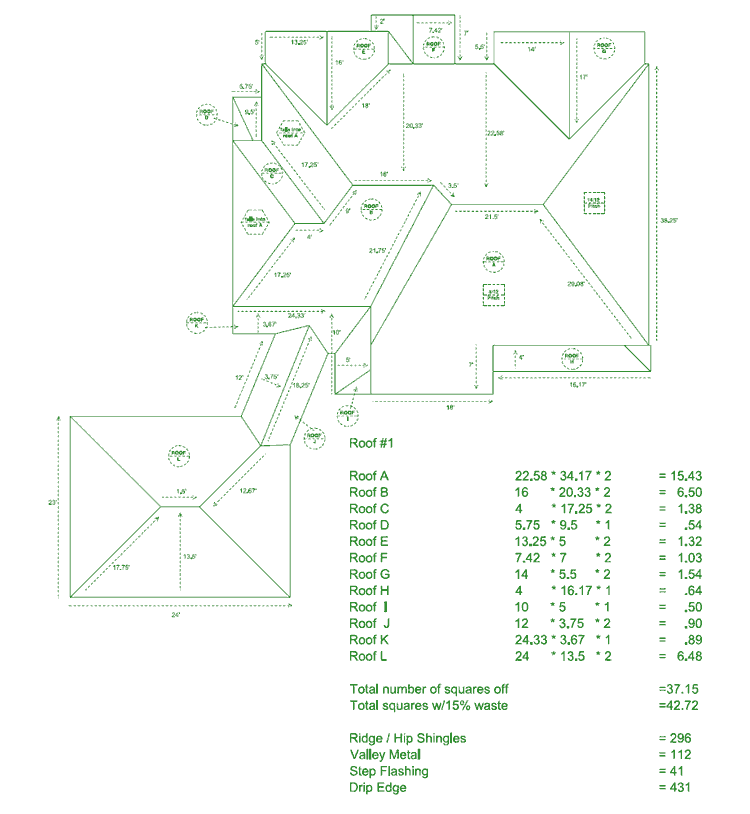


Unit Cost Pricing for Roofing
What Can & Cannot Be Included
The Unit Cost Pricing method was developed many years ago to make estimating insurance losses much quicker and more efficient. Due to its simplicity, it has also allowed those that are not necessarily experts in theconstruction field to accurately estimate the costs of large construction projects. Unit Cost Pricing is defined as:
The average, all inclusive, cost for a specific task.
For example, Roofing a home can be "Unit Costed" by the square (100 Square feet) once you know the exact amount of shingles, nails and labor it would take to
cover one single roofing "Square”. Once the cost for that single square has been established it can be accurately extrapolated to every claim that the adjuster
is estimating. I am sure you can see how this is much faster for an adjuster than attempting to figure the individual components
every time the need arose. It also allows for someone who has no experience as a roofer to be able to accurately estimate the cost.
There are, however, limitations to Unit Cost Pricing. Any items that may be different from one job to another would be physically impossible be
included in a unit cost. For example, some roofs are very complex in design and have much more Linear Footage of ridge / hip shingles
and edge metal than would a simpler gable roof. A more complex roof may also have hundreds of feet of valley metal or step flashing where a simple gable roof
would have none at all. Since the amounts of these materials will differ from roof to roof it would not be possible to factor these items into a unit cost for roofing.
In the roof examples below you can clearly see how two roofs with the same exact square footage of roofing shingles will cost vastly different amounts to replace due to the differences not able to be included in a unit cost. These items are;
| Roof #1 | Roof #2 | Difference | Unit Cost | Total | ||||
| Ridge / Hip Shingles | =296 |
= 75 | = 221 Lf |
$2.40 | $530.40 | |||
| Valley Metal | =112 |
= 0 | = 112 Lf |
$3.79 | $424.48 | |||
| Step Flashing | =41 |
= 0 | = 41 Lf |
$3.74 | $153.34 | |||
| Drip Edge | =431 |
= 249 | = 182 Lf |
$1.87 | $340.34 | |||
Grand Total of Difference |
$1,448.56 | |||||||
| Material Sales Tax | $ 59.75 |
|||||||
| 20% Overhead & Profit | $ 301.66 | |||||||
| $1,809.97 | ||||||||
If someone were to have tried to include the above items in the unit cost of the roofing shingles then they would have been either over paying or under
paying by $1,809.97 on these roof examples alone. This is why it is critical that certain materials are figured separately.
It has also been alleged that one can merely increase the waste factor for the shingles to compensate for these extra materials. This is incorrect. Most
people who have attempted this method add approximately 5% additional to the waste. You will note and additional 5% equates to only an additional
1.85 squares. With the price of shingles at $175 per square this would only be an additional $318.50. The difference above of $1,809.97 less the
$323.75 still leaves a deficit of $1,486.22. In fact if one were to figure the exact amount of waste necessary to compensate for the differences of these
two particular roofs it would come out to a 28.2% waste factor. Note that this is only to make up for the difference in cost of the above four items.
Extra waste would have to be factored in to allow for the actual waste of the shingles and starter course. In this example it would be customary to add
17% for a roof with so many angles. The waste factor would then total 45.2%. In addition, we would not know this percentage unless we had the
measurements of the items above in the first place.

